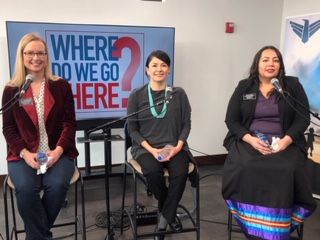In South Dakota and across the country, women will play a larger role in lawmaking and policymaking at almost all levels of government in 2019.
The new U.S. Congress will feature a record number of women in both the House and Senate. South Dakota will have its first female governor when Kristi Noem takes office in January. The South Dakota Legislature will be home to a near-record number of women, several of whom were elected for the first time this fall. And Noem recently named Kim Vanneman as the state’s first female agriculture secretary.
Among the contingent of women entering lawmaking in South Dakota, there exists a growing esprit de corps and a feeling of excitement that new issues, new voices and a new sense of collaboration will arise in the 2019 session that starts in January.
“Women are feeling like, ‘Hey, things are not where we want them to be, and we have ideas and answers that haven’t been considered,” said Linda Duba, a Representative-elect and first-time lawmaker from Sioux Falls. “So, we said, ‘OK, let’s go get a seat at the table.”
The rise of women in Congress and the state Legislature results in part from concerted efforts to encourage more women to run for elected office. In the wake of the 2016 presidential election, groups were formed specifically to provide qualified women with the knowledge, resources and support to run for office.
Based on interviews with several incoming female lawmakers, the influx of women into the Legislature could lead to a greater focus on issues such as improving access to health care, beefing up the state education system especially at the pre-kindergarten level and creating more jobs and economic opportunities for younger people and the working poor.
While those issues are not gender-specific, they may get a stronger push this session from female lawmakers who have different perspectives and life experiences than men.
Furthermore, the incoming women say they will bring a heightened sense of bi-partisanship and collaboration that they say has been missing in state and federal lawmaking.
“I definitely think there will be a louder voice from women than we’ve had in the past,” said Erin Healy, a representative-elect from Sioux Falls. “A few of us are trying to actively figure out a way that we can get all the women together, regardless of political affiliation, to work on specific issues.”
One expert suggests that the surge in female leadership in South Dakota and America is just beginning.
“This has been a great year for women running for office,” said University of South Dakota political science professor Julia Hellwege, who studies the role of gender and race in elections.
“We’re going to see continuous growth because as more women see more other women in office, they’ll say, ‘Yeah, I can do that as well.’”

Not yet full representation
Even with more women in the state Legislature in 2019, the state is far from seeing full representation of its female population.
The population of South Dakota is made up 49.5 percent women, yet the incoming class of lawmakers will be only 24 percent female. In all, 25 female lawmakers will travel to Pierre for the session that starts Jan. 8. The 2019 roster of lawmakers has four more women than in 2018 and near the record of 26 who served in the 1991-92 session, according to the South Dakota Legislative Research Council. Still, the new contingent is a far cry from the three women who served in 1971-72 and the 11 who served in 1981-82.
Only two leadership positions will be occupied by women: Republican Sen. Kris Langer of Dell Rapids will serve as majority leader in the Senate, and incoming Democratic Rep. Erin Healy of Sioux Falls was named a minority whip in the House.
According to the Center for Women and Politics at Rutgers University, South Dakota ranked 34th among the 50 states for women in the state legislature with 21 percent female lawmakers in 2018. With four more women lawmakers in 2019, that ranking could rise but will depend on how many women were elected in other states.
The state is behind the 2018 national average of 26 percent women in state legislatures.
Studies have shown that women and men tend to win elections at roughly the same rate, so the disproportionately small number of women in office is likely due to fewer women than men seeking office, said Hellwege.
The state saw a record number of women run for the Legislature in 2018, a total of 61 with 25 winning election, according to the Center for Women and Politics..
The structure of the South Dakota Legislature, with an annual session held in the middle of the state, makes it easier for retirees, business owners and the independently wealthy to hold office than for working women and mothers.
The female newcomers to the statehouse have a wide breadth of life experiences and ages. They range in age from the early 30s to the mid-60s with vocations including bartender, non-profit executive, archivist, engineer, employment investigator and homemaker.
The number of women who ran for office in 2018 was boosted by the recent formation of groups that encourage women to enter public service and advise them on how to run a successful campaign, Hellwege said. Efforts to recruit more women were bolstered by rise of the #MeToo movement against sexual harassment and the election of President Donald Trump, who has made off-color and patronizing statements about women, she said.
In South Dakota, the non-partisan Ready to Run group is an offshoot of a national female candidate support effort. Similarly, the Leaders Engaged and Determined group, known as LEAD, was formed by a small group of Sioux Falls women after the 2016 presidential election in which Trump defeated Hillary Clinton.
The groups provide potential candidates with networking opportunities, training on fundraising and campaigning and the moral support to realize they can win elected office, Hellwege said.
Often, women may not run for office unless someone encourages or asks them to do so, Hellwege said.
Three female Democratic candidates who participated in LEAD were elected this fall: Duba, Healy and Kelly Sullivan, all of Sioux Falls.
While it is unclear if a surge of women in government will cause new or different issues to arise, women have historically been more comfortable to address some topics that aren’t top of mind for men, such as birth control or women’s and children’s health, said Hellwege.
“Children and family issues may be highlighted more, and women who are moms are more likely to prioritize those issues more,” she said.
Female lawmakers may also see issues with a different perspective than men, she said, such as considering educational opportunities rather than just fiscal considerations as a critical component of a debate over expanding workforce options.
"I want the next generation, and for me that next generation is my nieces, to know and remember that when you make up your mind to do something, and have a solid plan and you’re committed, that you have a good chance of being successful in running for office." – Scyller Borglum.
Downplaying gender, focusing on legislating
Like Governor-elect Noem, Scyller Borglum of Rapid City has downplayed the impact her gender had on her decision to run, on her election and how she will legislate.
Borglum, 41, is a representative-elect from Rapid City who said she ran first and foremost as a Republican and Christian, then as a scientist and engineer and finally as someone who will work with any other willing lawmaker to improve things for her state and its residents.
“I have not met anybody who’s run for the state Legislature as a woman, where that was their platform,” said Borglum, a graduate of the South Dakota School of Mines & Technology who works as a research engineer in the geomechanics lab at Respec, an industrial engineering firm in Rapid City. “I hesitate to emphasize gender because in the end we’re all working on the important issues facing the state.”
Yet Borglum is cognizant that she is part of a wave of women entering the Legislature, and she embraces what she said can be a fresh approach to studying issues in a collaborative, bi-partisan way.
During new lawmaker orientation in December, Borglum struck up an immediate friendship with Senator-elect Red Dawn Foster of Pine Ridge, a Democrat. Borglum said the pair share a goal to work hard to improve life for South Dakotans.
Some of their stated priorities differ. Foster promotes Medicaid expansion, backs labor unions and wants improved protection of state land and water resources from abuse by foreign business interests. Borglum, meanwhile, wants to tackle meth addiction, expand mental health treatment options and protect failing nursing homes.
Both incoming lawmakers, however, want to expand economic and employment opportunities for all state residents and share the goal of improving the state education system, particularly for younger students and Pre-K children.
“What you’re seeing are two women, very excited, who are doing this together,” Borglum said. “All of us pushing forward and pushing toward a common goal and recognizing that same thing in our fellow legislators — that’s where this positive energy is coming from.”
Both women also said they hope to serve as an inspiration to others, women in particular, to seek elected office.
“I want the next generation, and for me that next generation is my nieces, to know and remember that when you make up your mind to do something, and have a solid plan and you’re committed, that you have a good chance of being successful in running for office,” Borglum said.
Foster and fellow Pine Ridge lawmaker Peri Pourier will also focus on improving conditions on South Dakota Indian reservations.
The pair hope to continue a historic pattern of strong Native women who take a determined approach to governing in the fight for positive change.
Pourier, a Democratic Representative-elect who is a military veteran, said she wants to help indigenous people by expanding access to health care, eliminating food deserts and improving safety and security on reservations.
“We’re dealing with survival factors; we’re dealing with survivability,” Pourier said at a recent panel discussion in Rapid City.
Some in the incoming wave of women lawmakers bring up early education, access to health care and finding ways to help the working poor as issues deserving more attention in Pierre

A push for collaboration
Another consistent message among the new crop of female lawmakers is increasing collaboration and reducing the binary partisanship that exists in government.
“I was really sick of the partisanship in Pierre and at the national level,” said Healy, a Democrat who works as an analyst at Midco Communications in Sioux Falls. “When I went around campaigning, that was often the conversation, that people were incredibly sick of issues coming up that were dominated by one party or the other.”
Communication may become more civil — and likely more effective — with more women involved in legislative debates, said Duba.
“Women in general are more gregarious that way; we come at people from a more personal than political approach,” Duba said. “It’s also refreshing when you have both genders in a room because you have more sharing of ideas.”
Duba, 62, is a retired corporate finance executive who now works as an educational assistant at an elementary school and was elected as a Democrat.
Duba said the further she worked her way up the corporate ladder, the more she became a minority as a woman. She said that women leaders tend to be more open than men to considering new ideas and sharing information in order to solve problems.
“It’s more of a collaborative style than a command style, not that men can’t be collaborative,” she said. “I’m not going to tell you that we’re like-minded, but I do find that women are more open to ideas and getting new information.”
Hellwege, the USD professor, said studies show that women see themselves as more collaborative but that the impression is not always reality.
“We do know that women themselves perceive themselves to be better listeners and more collaborative,” Hellwege said. “But the literature is actually somewhat mixed on that; some studies say that’s true and some say there’s really no gender difference.”
Hellwege said any shift that takes place in lawmaking due to stronger influence by women may show up only over time and only if the trend toward greater female involvement continues.
“Things will not change that much until women actually get to the leadership positions, which takes seniority,” she said. “It’s not enough to just get women into office, but they have to get into positions of leadership. We’re getting there, but there’s a long way to go.”





